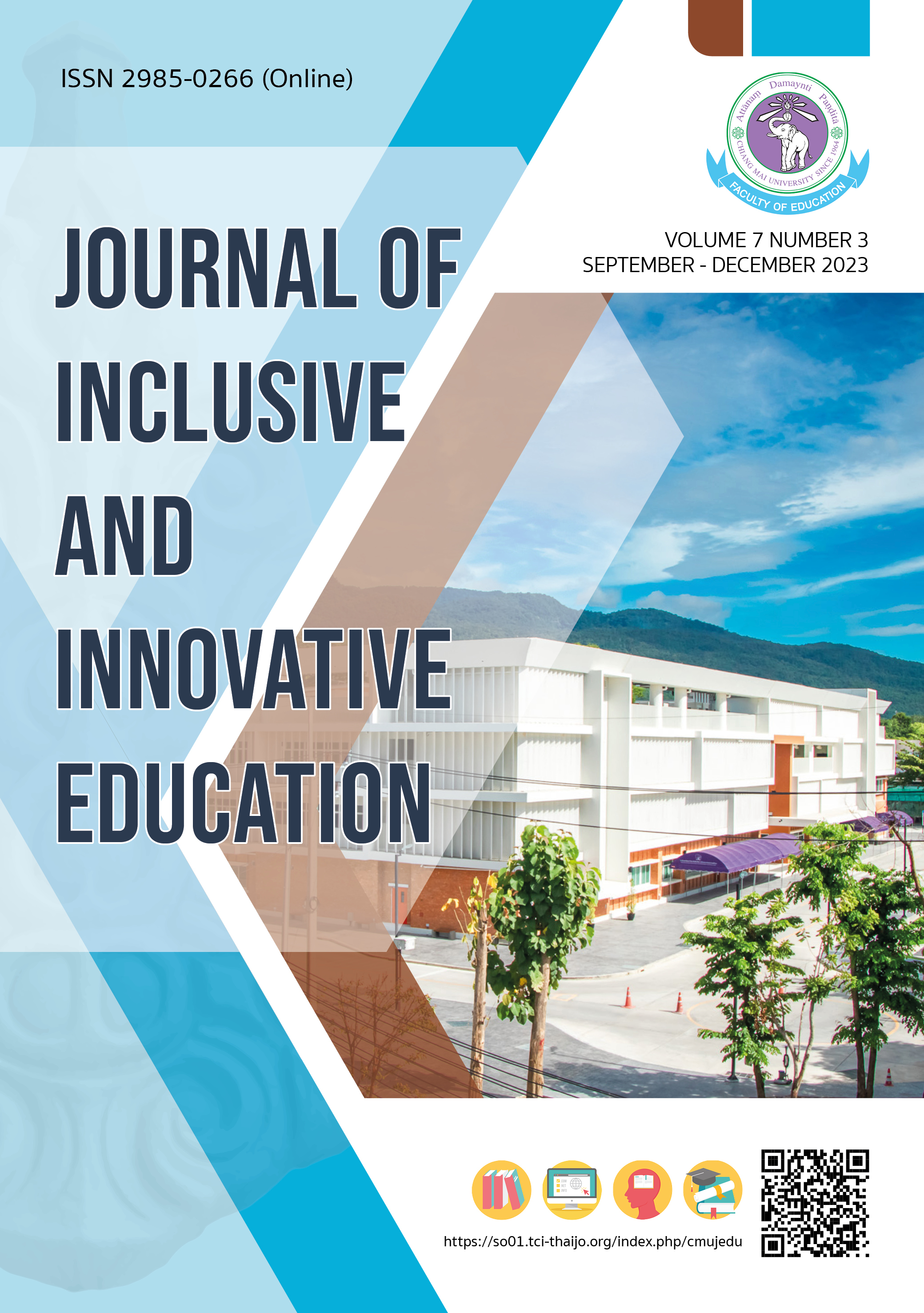จากแนวคิดสู่การปฏิบัติ: การสร้างห้องเรียนคณิตศาสตร์ที่เสมอภาค
Main Article Content
บทคัดย่อ
การสร้างห้องเรียนเสมอภาคเป็นเรื่องท้าทายสำหรับครูโดยเฉพาะสำหรับห้องเรียนคณิตศาสตร์ที่มีสัดส่วนนักเรียนที่มีปัญหาติด 0 หรือ ร ในสัดส่วนที่สูงเมื่อเทียบกับรายวิชาอื่น สิ่งเหล่านี้สะท้อนว่าการจัดการเรียนรู้ยังไม่สามารถเชื่อมต่อกับความต้องการของผู้เรียนทุกคนได้อย่างมีประสิทธิภาพ นักเรียนที่เรียนรู้ช้า มีอุปสรรคในการเรียนรู้ หรือ มีความรู้พื้นฐานไม่เพียงพอมักจะถูกละเลย แม้ว่านักการศึกษาพยายามส่งเสริมการสร้างห้องเรียนที่เสมอภาคและมีข้อเสนอแนะสำหรับการจัดการเรียนรู้ที่เน้นการตอบสนองความแตกต่างของผู้เรียน แต่ข้อเสนอแนะมักจะเป็นหลักการทั่วไป ไม่เฉพาะเจาะจงกับรายวิชา ส่งผลให้ครูคณิตศาสตร์ในฐานะผู้ปฏิบัติไม่มีตัวอย่างที่เป็นรูปธรรมของห้องเรียนคณิตศาสตร์ที่เสมอภาคและมองไม่เห็นความเป็นไปได้ในการปฏิบัติ ทำให้เป็นอุปสรรคในการผลักดันแนวคิดไปสู่การปฏิบัติจริงในห้องเรียน บทความนี้มีจุดมุ่งหมายในการนำเสนอแนวคิดและแนวปฏิบัติในการสร้างห้องเรียนคณิตศาสตร์ที่เสมอภาคอย่างเป็นรูปธรรม โดยการผสานแนวคิดห้องเรียนเสมอภาคที่ตอบสนองความแตกต่างของผู้เรียนแบบเรียนร่วมกับแนวคิดการจัดการเรียนรู้คณิตศาสตร์ที่มีประสิทธิภาพ โดยข้อเสนอแนะและบทสรุปในการจัดการเรียนรู้เพื่อสร้างห้องเรียนคณิตศาสตร์ที่เสมอภาคนี้เป็นผลจากการสกัดแนวปฏิบัติจากห้องเรียนกรณีศึกษาในระดับชั้นมัธยมศึกษาปีที่ 3 แผนการเรียนรู้ศิลป์สร้างสรรค์ของโรงเรียนมัธยมศึกษาขนาดใหญ่แห่งหนึ่งในภาคเหนือ ซึ่งแสดงให้เห็นมุมมองของผู้สอนต่อห้องเรียนเสมอภาคและกระบวนการออกแบบกิจกรรมการเรียนรู้ที่มาจากแนวคิดห้องเรียนคณิตศาสตร์ที่เสมอภาค
Article Details

อนุญาตภายใต้เงื่อนไข Creative Commons Attribution-NonCommercial-NoDerivatives 4.0 International License.
หากผู้เสนอบทความมีความจำเป็นเร่งด่วนในการตีพิมพ์โปรดส่งลงตีพิมพ์ในวารสารฉบับอื่นแทน โดยกองบรรณาธิการจะไม่รับบทความหากผู้เสนอบทความไม่ปฏิบัติตามเงื่อนไขและขั้นตอนที่กำหนดอย่างเคร่งครัด ข้อมูลของเนื้อหาในบทความถือเป็นลิขสิทธิ์ของ Journal of Inclusive and Innovative Education คณะศึกษาศาสตร์ มหาวิทยาลัยเชียงใหม่
เอกสารอ้างอิง
Boaler, J. (2022). Mathematical mindsets: Unleashing students’ potential through creative mathematics, inspiring messages and innovative teaching. New Jersey: John Wiley & Sons.
Chaiyong, S. (2022). “Equitable Classroom” The concept of learning management that leaves no one behind the classroom. CMU Journal of Education, 6, 14-28. [in Thai]
Cohen, E. G., Lotan, R. A., Scarloss, B. A., & Arellano, A. R. (1999). Complex instruction: Equity in cooperative learning classrooms. Theory into practice, 38(2), 80-86.
Gutiérrez, R. (2002). Enabling the practice of mathematics teachers in context: Toward a new equity research agenda. Mathematical Thinking and Learning, 4, 145–187.
Gutiérrez, R. (2012). Context matters: How should we conceptualize equity in mathematics education?. In B. Herbel-Eisenmann, J. Choppin, D. Wagner, & D. Pimm (Eds.), Equity in Discourse for Mathematics Education: Theories, Practices, and Policies (pp. 17–32). New York: Springer.
Heng, T. T., & Song, L. (2020). A proposed framework for understanding educational change and transfer: Insights from Singapore teachers’ perceptions of differentiated instruction. Journal of Educational Change, 21, 595–622.
Devlin, K. (2000). The math gene: How mathematical thinking evolved and why numbers are like gossip. Great Britain: Basic Books.
National Council of Teachers of Mathematics. (1991). Professional standards for teaching mathematics. VA: National Council of Teachers of Mathematics.
National Council of Teachers of Mathematics. (2014). Principles to action: ensuring mathematical success for all. VA: National Council of Teachers of Mathematics.
Nillapun, M., Vanichwatanavorachai, S., & Makjui, A. (2013). The development of instructional innovation based on differentiated instruction. Silpakorn University Journal, 33, 83–105. [in Thai]
Ounraun, W., & Onthanee, A. (2023). An instructional model development based on social constructivism and authentic learning approaches to enhance differentiated instruction ability for student teachers. Journal of Education Naresuan University, 25, 222-237. [in Thai]
Panich, V. (2019). Equitable classroom. Retrieved from https://www.gotoknow.org/posts/660998. [in Thai]
PISA Thailand. (2021). PISA 2018 results reading, mathematics and science. Bangkok: IPST. [in Thai]
Sankaburanurak, A., & Sankaburnurak, S. (2015). Differentiated instruction. Silpakorn University Journal, 12, 39-48. [in Thai]
Shulman, L. S. (1986). Those who understand: Knowledge growth in teaching. Educational Researcher, 15, 4–14.
Tomlinson, C. A. (2001). How to differentiate instruction in mixed-ability classrooms (2nd ed.). Alexandria, VA: Association for Supervision and Curriculum Development.
Tomlinson, C. A., Brighton, C., Hertberg, H., Callahan, C. M., Moon, T. R., Brimijoin, K., Conover, L. A., & Reynolds, T. (2003). Differentiating instruction in response to student readiness, interest, and learning profile in academically diverse classrooms: A review of literature. Journal for the Education of the Gifted, 27, 119–145.
UNESCO. (2017). A guide for ensuring inclusion and equity in education. Retrieved from https://unesdoc.unesco.org/ark:/48223/pf0000248254.


